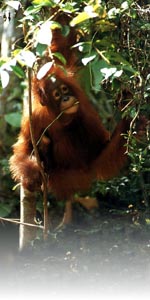Peace-Loving Primates' Population Plummets
Washington - Bonobos, or pygmy chimpanzees, arguably our closest relative, may have been hunted so extensively that the survival of the species is at risk, World Wildlife Fund warns."The world could soon lose the primate species that shares the greatest genetic connection to humans," said Richard Carroll, a primatologist and director of WWF's Central Africa program. "Bonobos are fascinating creatures and little understood. They have the only great ape society led by females, with a sophisticated social structure that encourages cooperation and peace and settles disputes through sex. If humans allow our closest relatives to go extinct, we have failed as a species."
Found only in the war-torn Democratic Republic of Congo in Central Africa, bonobos were believed to number as many as 50,000. But preliminary results from the first systematic survey of a known bonobo stronghold found more evidence of poachers than bonobos, indicating that there may be as few as 10,000 left in the wild. Bonobos, along with other species, are targeted by hunters for meat for personal consumption and for the commercial bushmeat trade.
The survey was conducted in Congo's 90,000-square-mile Salonga National Park, a protected area the size of Holland. The first data available, from about a third of the park, show evidence of very few bonobos living there. No bonobos were encountered, and nests and dung were seen in only a quarter of the area surveyed, at lower densities than previously measured. In contrast, there was abundant evidence of human encroachment into the park and of poaching. WWF hopes to be able to establish a clearer picture of how many bonobos are left in the wild once all of the results of the survey have been compiled and analyzed early next year.
The findings coincide with the 75th anniversary of the scientific description of bonobos, close relatives of the chimpanzee that were mistaken for chimps until a German scientist described them as a new species in 1929.
"These preliminary results are obviously disturbing," Carroll said. "Salonga National Park was created in 1970 specifically to safeguard bonobos and we thought it was the least disturbed and best protected habitat for the bonobo. Based on how bad it looks here, we can assume that across the Congo, bonobos are in crisis."
The survey of Salonga National Park, supported by WWF, was undertaken by the Congolese Institute for Nature Conservation and the Wildlife Conservation Society. During the long-running civil war in the country, it became almost impossible for Congolese wildlife authorities to effectively protect the country's national parks. Increased poaching by armed militias and local people was inevitable, with serious consequences for the bonobos of Salonga as well as the local people.
WWF has now launched a new project to monitor and protect surviving bonobo populations in the northern sector of Salonga National Park. It is providing park staff and researchers with training and equipment as well as supporting anti-poaching operations on foot and by boat to stop the illegal killing of the rare apes. The project is being implemented by Congolese Institute for Nature Conservation and the Zoological Society of Milwaukee in partnership with WWF's USAID/EU-funded Salonga Landscape Program.
"The war has had terrible consequences for the people and wildlife of the Congo Basin," said Lisa Steel, co-ordinator of WWF's Salonga program. "However, now, as the Democratic Republic of Congo rebuilds socially and economically, the opportunity is there to make sure that forest conservation benefits not only wildlife but also local people."
Bonobos live in matriarchal societies that reinforce cooperation, and unlike male-dominated chimpanzee troops, exhibit little aggression toward each other. The species resolves conflict through sex, a behavior not found in other primates and one that strengthens group cohesion. Although often equal in height to chimpanzees, bonobos' limbs are more slender; they have smaller, more rounded skulls; and they have a black face with reddish lips.
nextHOME
HedWeb
HerbWeb
BLTC Research
Animal Rights FAQ
Bonobo Fact Sheet
Paradise-Engineering
Bonobos and Humans
Monkey sex in the brain
Bonobo sex photography
dave@bltc.com

